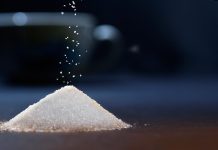
Hi. I’m trying to cut down on the number of sugars I eat. Since food labels typically show how many grams of sugar are in a serving, how can I know what a good “goal” should be?
I’d like to record how many grams I eat now and then compare it to how many grams I should be eating. What about the percentage of sugars to carbohydrates? I can easily find a carbohydrate goal for my height and weight, but how much of that should be in the form of sugars? For example, if my carbohydrate goal is 300 grams per day, how many of those grams should be sugar?
The U.S. Dietary Guidelines suggests 10% of calories from sugar. So if your goal is 300 grams of carbohydrate per day, then 30 grams can come from sugar. However, 0 grams of added sugars would be ideal.
The new FDA food label (Food and Drug Administration) required of food manufacturers starting July 26, 2018, now lists added sugars which includes sugars added by food manufacturers during processing. Whereas, the previous food label lumped total sugars together including milk (lactose), fruit sugar (fructose), and starch (maltose) along with added sugars. For instance, one serving of fruit canned in fruit juice has 14 grams of carbohydrate and 1 cup of skim milk has 12 grams of carbohydrate which were both included with Total Sugars on the previous food label. Yet neither of these foods has sugar added. Luckily, the new food label will separately require added sugars from naturally occurring sugars in food.
Carbohydrates, including sugars, are your body’s main source of energy. There are two forms of sugar in the food we eat. There are naturally occurring sugars in fruits, dairy products, and starches. There are added sugars (white, brown, raw, or powdered sugar as well as corn syrup solids and high fructose corn syrup) in processed foods.
First, start by reading the ingredient list on a food label. Learn to differentiate between ingredients that are added sugars (high fructose corn syrup, sucrose). If these sugars (lactose, fructose, maltose) are listed on food label ingredient lists that means they are added by food manufacturers. It may take some leaning on your part to recognize ingredients that contribute to added sugars on food labels. Natural sugars like lactose (milk sugar), fructose (fruit sugar), or maltose (malt from starch) that are in raw foods will not be listed as an added sugar. Make sense?
When you eat foods that contain added sugars, choose foods that also contain nutrients like vitamins, minerals or fiber. Limit foods that are high in sugar with few other nutrient values (i.e. 15% vitamin C) listed on the food label. Avoid foods such as candy, non-diet carbonated beverages, jam, jelly, and syrup. You should get most of your carbohydrates from dairy foods, fruit, and starchy foods such as pasta, rice, bread, whole grains, potatoes, and starchy vegetables like corn or peas. These foods are preferred sources of carbohydrates, vitamins, minerals, and fiber. These foods are considered to be rich in nutrients. Fruit and fruit juice is another great source of carbohydrates that can provide vitamin A, C, folacin, potassium, and other important nutrients. When you choose foods that contain added sugars, read the food labels to make sure you’re getting some nutrients to go along with your sugar. Remember that moderate amounts of sugar, no matter what their source, are part of a healthy eating plan.



